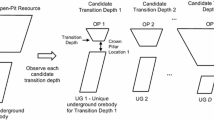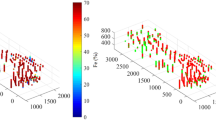Abstract
Economic characterization of mining parcels depends upon geo-metallurgical properties, which vary throughout orebody. Mine production scheduling should aim to obtain maximum utility from orebody in such a way as to ensure mine–mill reconciliation. As heterogeneity of geo-metallurgical variables increases, the scheduling will be a very complicated task. Geo-metallurgical and financial data used in the mine production scheduling are based on simulation and/or estimation generated from sparse drilling and unknown future events. Therefore, the scheduling process involves a significant degree of uncertainty. In order to deal with the uncertainty stemmed from geo-metallurgical and financial variables, two approaches are recommended in this paper. Firstly, mine production scheduling is formulated as a problem of stochastic programming with recourse. The extraction periods of mining blocks are treated as the first-stage variables and the block destinations represents a recourse vector. It is observed that the solution is implicitly robust. Secondly, the scheduling is expressed as a maximin problem to extract more uniform metal quantity in periods to coincide with mill requirements instead of maximization of net present value because the blending constraint in the traditional approach forces more uniform production. In the case where there is correlation between grade and geo-metallurgical variables, this model generates reasonably good results.



Similar content being viewed by others
References
Akaike A and Dagdelen K (1999). A strategic production scheduling method for an open pit mine. In: Dardano C, Francisco M and Proud J (eds). Proceedings of 28th APCOM Symposium (Application of Computers and Operations Research in the Mineral Industry), SME/AIME Publication: Littleton, pp 729–738.
Barboro A and Bagajewicz MJ (2004). Managing financial risk in planning under uncertainty . AICHE J 50: 963–989.
Boland N, Fricke C and Froyland G (2006). A strengthened formulation for the open pit mine production scheduling problem, http://www.optimization-online.org/DB_FILE/2007/03/1624.pdf, accessed 15 November 2007.
Boland N, Dumitrascu I, Froyland G and Gleixner A (2009). LP-based disaggregation approaches to solving the open pit mining production scheduling problem with block processing selectivity . Comput Opns Res 36: 189–1064.
Caccetta L and Hill SP (2003). An application of branch and cut to open pit mine scheduling . J Global Optim 27: 349–365.
Dagdelen K and Johnson TB (1986). Optimum open pit mine production scheduling by lagrangian parameterization. In: Ramani RV (ed). Proceedings of 19th APCOM Symposium (Application of Computers and Operations Research in the Mineral Industry) Proceedings. SME/AIME Publication: Littleton, pp 127–142.
Deutsch VC and Journel AG (1998). GSLIB: Geostatistical Software Library and User's Guide, 2nd edn. Oxford Press: New York.
Dowd PA (1989). The design of a rock homogenising stockpile . Mineral Processing in the UK. IMM: London pp 63–82.
Dowd PA (1994). The optimal design of quarries . In: Whateley MKG and Harvey PK (eds). Mineral Resource Evaluation II. The Geological Society: London, pp. 141–155.
Elevli B, Dagdelen K and Salamon M (1990). Single time period production scheduling of open pit . Mining Eng 103: 1888–1893.
Evans AM (1997). An Introduction to Economic Geology and its Environmental Impact . Wiley-Blackwell Science: London.
Gershon ME (1983). Optimal mine production scheduling: Evaluation of large scale mathematical programming approaches . Int J Mining Eng 1: 315–329.
Gy PM (1981). A New theory of bed-blending derived from the theory of sampling—development and full-scale experimental check . Int J Miner Process 8: 201–238.
Higle JL (2005). Stochastic programming: Optimization when uncertainty matters. Tutorials in Operations Research, INFORMS, http://ie.tamu.edu/INEN689-602/Papers/HigleInforms05.pdf, accessed 5 May 2007.
Hochbaum DS (2001). A New-old algorithm for minimum-cut and maximum-flow in closure graphs . Networks: An Int J 37: 171–193.
Journel AG and Isaaks E (1984). Conditional indicator simulation: Application to a Saskatchewan uranium deposit . Math Geol 16: 685–718.
Kall P and Wallace SW (1994). Stochastic Programming, 1st edn. John Wiley and Sons: Chichester.
Kaplan S (1974). Applications of programs with maximin objective functions to problems of optimal resource allocation . Opns Res 22: 802–807.
Kernot C (1999). Valuing Mining Companies . Woodhead Publication: Cambridge.
Kumral M (2006). Bed blending design incorporating multiple regression model and genetic algorithms . J Southern Afr Inst Min Metall 106: 229–236.
Lerchs H and Grossman IF (1965). Optimum design of open-pit mines . CIM T 58: 47–54.
Menabde M, Froyland G, Stone P and Yeates G (2004). Mining schedule optimisation for conditionally simulated orebodies . In: Dimitrakopoulos R (ed). Proceedings of Orebody Modelling and Strategic Mine Planning—Uncertainty and Risk Management. AusIMM Publication: Perth, pp. 342–357.
Ramazan S and Dagdelen K (2005). Fundamental tree algorithm in optimising production scheduling for open pit mine design . Min Technol : IMM T (Sec A) 114: 45–54.
Robinson GK (2004). How much would a blending stockpile reduce variation? Chemometric Int Lab Syst 74(1): 121–133.
Sen S and Higle JL (1999). An introductory tutorial on stochastic linear programming models . Interfaces 29(2): 33–61.
Van Slyke R and Wets RJB (1969). L-shaped linear programs with applications to optimal control and stochastic programming . SIAM J Appl Math 17: 638–663.
Weintraub A, Pereira M and Schultz X (2008). A priori and a posteriori aggregation procedures to reduce model size in MIP mine planning models . Electron Notes Discrete Math 30: 297–302.
Zhao Y and Kim A (1992). A new optimum pit limit design algorithm . In: Ramani RV (ed). Proceedings of 23rd APCOM Symposium (Application of Computers and Operations Research in the Mineral Industry) Proceedings. SME/AIME Publication: Littleton, pp. 500–506.
Author information
Authors and Affiliations
Corresponding author
Rights and permissions
About this article
Cite this article
Kumral, M. Incorporating geo-metallurgical information into mine production scheduling. J Oper Res Soc 62, 60–68 (2011). https://doi.org/10.1057/jors.2009.174
Received:
Accepted:
Published:
Issue Date:
DOI: https://doi.org/10.1057/jors.2009.174




